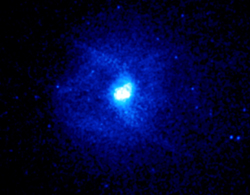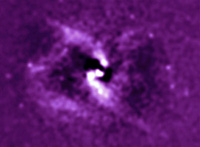December 19, 2001
RELEASE: 01-252
NASA's Chandra X-ray Observatory has revealed the aftermath of a titanic explosion that wracked the elliptical galaxy known as NGC 4636. This eruption could be the latest episode in a cycle of violence that is triggered by gas falling into a central massive black hole.
Chandra's images of NGC 4636 show spectacular symmetric arms, or arcs, of hot gas extending 25,000 light years into a huge cloud of multimillion-degree-Celsius gas that envelopes the galaxy. At a temperature of 10 million degrees, the arms are 30 percent hotter than the surrounding gas cloud.
"The temperature jump, together with the symmetry and scale of the arms, suggests that we are observing the effects of a tremendous outburst that occurred in the center of the galaxy," said Christine Jones of the Harvard-Smithsonian Center for Astrophysics in Cambridge, Mass., lead author of a paper on these observations scheduled for publication in Astrophysical Journal Letters. "The energy of this explosion would be the equivalent of several hundred thousand supernovas."
The arms appear to be the leading edges of a galaxy-sized shock wave that is racing outward at 700 kilometers per second, or 1.6 million miles per hour. At this speed, it would take 3 million years for the structures to attain their present size. Cavities detected in the hot gas cloud to the east and west of the center of the galaxy support the shockwave explanation.
The authors suggest that the explosion is part of a majestic cosmic feedback process that keeps the galaxy in a state of turmoil. Over a period of a few million years, a hot gas cloud that envelops the stars in the galaxy cools and falls inward toward a central, massive black hole. The feeding of the black hole by the infalling material leads to an explosion that heats the hot gaseous envelope, starting the cycle anew.
This feedback cycle may explain one puzzling feature of the galaxy - the lack of a strong radio source of the type that is usually observed in connection with galactic outbursts.
"It may be that we are seeing an early stage of the cycle before the radio source has turned on," said team member William Forman also of the Harvard-Smithsonian Center for Astrophysics. "Or, it could be a new type of outburst that is not accompanied by strong radio emission."
Other members of the team included Alexey Vikhlinin, Maxim Markevitch, Laurence David, Aryeh Warmflash, all of the CfA, and Paul Nulsen of the University of Wollongong in Australia. Chandra observed NGC 4636, an elliptical galaxy in the constellation Virgo some 50 million light years from Earth, with the Advanced CCD Imaging Spectrometer (ACIS) on Dec. 4-5, 1999 for 11,000 sec, and Jan. 26-27, 2000 for 53,000 seconds as part of a program led by Richard Mushotzky of NASA's Goddard Space Flight Center to study X-ray emission from elliptical galaxies.
The ACIS instrument was developed for NASA by Pennsylvania State University, University Park, and Massachusetts Institute of Technology, Cambridge. NASA's Marshall Space Flight Center in Huntsville, Ala., manages the Chandra program, and TRW, Inc., Redondo Beach, Calif., is the prime contractor for the spacecraft. The Smithsonian's Chandra X-ray Center controls science and flight operations from Cambridge, Mass.
MEDIA CONTACTS
Dolores Beasley
Headquarters, Washington, DC
Phone: 202-358-1753
Steve Roy
Marshall Space Flight Center, Huntsville, AL
Phone: 256-544-6535
Megan Watzke
Chandra X-ray Observatory Center, CfA, Cambridge, MA
Phone: 617-496-7998




